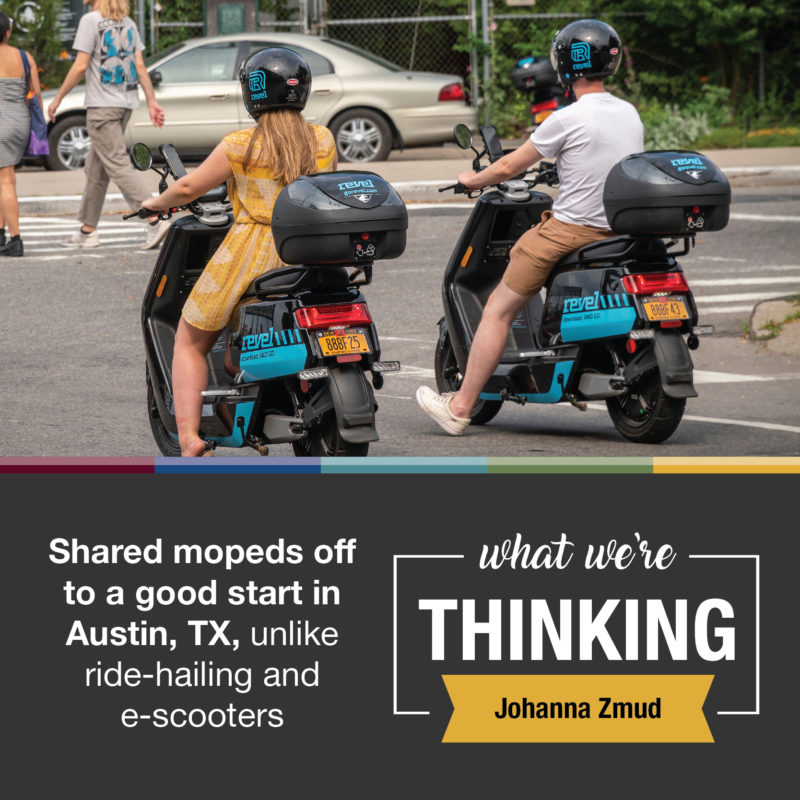Deploying Revel mopeds has already been a favorable experience compared to other mobility experiments, in-part due to the company’s willingness to share trip data.
Shared sit-down scooters have arrived on Austin streets, the first in Texas after starting in New York and Washington, DC. Already, the experience differs favorably to other mobility experiments in recent memory – starting with a willingness by Revel (the shared moped start-up) to work with the City of Austin to share trip data.
Sensible as that seems, it didn’t happen when ride-hailing and e-scooters burst onto busy local streets.
In 2014, Lyft and Uber stormed in, hauling passengers in direct conflict with city ordinances. E-scooter companies Bird and Lime followed the same ask-forgiveness-not-permission model, covertly dropping thousands of their sleek rides on city streets last year without warning or authorization.
In both cases, municipal leaders had to play catch-up in regulating a private service on public rights-of-way, after the service was already up and running and gaining in popularity. City officials were caught between the pressure of a mobility-hungry public and a responsibility to ensure the safety of that public. Rock, meet hard place.
In sharp contrast, Revel started working with city officials before launching its service, ensuring that this rollout would be better coordinated and far less awkward for everybody concerned. That distinction alone should earn the folks at Revel a gold star.
Things are off to a promising start, but as with any new innovative venture, there’s the potential for stumbles and the occasional unintended consequence. Whether or not the moped venture is successful will depend on how we can answer three questions months or years from now.
What was the effect on safety?
To rent one of its mopeds, Revel requires a current driver license, so users should presumably have knowledge of road rules (like a prohibition on lane-splitting, legal only in California). Third-party liability insurance is included in the rental, so that base is covered, too. Helmets, provided with each ride, are required (though that could be a tough point to get across in a state without a helmet law for motorcyclists).
What’s not required is a motorcycle license. The company offers free safety lessons, though there’s nothing on its website to suggest the lessons are mandatory. Consequently, riders could be taking to the streets without any of the skills unique to operate a two-wheeled motor vehicle. In many cases, the absence of those skills won’t be apparent before the moment something goes wrong.
The Centers for Disease Control and Prevention (CDC) last year finished a first-ever study in Austin, examining stand-up scooter crash frequency and severity, and identifying risk factors, based on data from nearly one million scooter trips. Another baseline study should be done at an appropriate time to examine seated scooter crashes.
What was the effect on overall mobility?
It’s uncertain whether the new scooters will displace car and pickup volume, or just add more road space demand to a city already plagued by traffic congestion. And though they’re relatively small, any allowance for buffer space could mean they take up almost as much room as a compact car.
Regulations say that the mopeds can be parked in any parking space. So, how much finite parking capacity will be chewed up by this new mode, and how will that exacerbate the already challenging hunt for those spaces, especially downtown?
Shared mopeds may provide a transportation solution for people who use them, but how they impact everybody else — and the transportation system in general — remains to be seen.
Is this a sustainable solution, or another shiny object?
Mopeds won’t be all things to all people, not any more than shared bikes or e-scooters have been. They won’t be practical under certain conditions; with a top speed of 29 mph, you can’t take them on highways, and you can’t use them to haul luggage to the airport.
It’s tough to say exactly what transportation niche they’ll end up filling and whether that niche will be different in Austin than it is in other cities. At this point, we just don’t know the answers to these questions. We do, however, know how to find out. Just show us the data.
Data sharing is a two-way street. Not only can it allow the city to understand the effects of this new mobility option; it can also enable service providers and users to get real-time information on things like detours and emergency road closures. Thankfully, Revel and the City of Austin seem to recognize the possibilities that cooperation can afford.
Johanna Zmud is a senior research scientist at the Texas A&M Transportation Institute.
This article was originally published in Smart Cities Dive, December 18, 2019.
